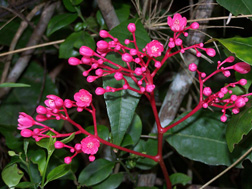Puerto Rico
An Island Source of Extraordinary Ornamentals
|
|
Thanks to ARS germplasm collection efforts, the rare Puerto Rican Tabebuia haemantha, an evergreen tree that is small in stature but bold in color, may one day be grown and sold in Florida and other subtropical U.S. regions. Native to Puerto Rico, T. haemantha, also known as “roble cimarron,” possesses many features of interest to ornamental horticulturists. Its red- to bronze-colored new growth naturally forms a narrow crown, and it has deep-red to pink flowers for a long period of the year.
The U.S. horticultural market is one of the world’s largest, with more than $45 billion in sales in 2005. But despite its huge value, the industry also has its problems. For example, few plant breeders ever turn a profit, and very few of them have the resources to fund research or travel to foreign countries in search of cost-effective alternatives to current U.S. nursery offerings. But a pair of ARS scientists is on the case, pursuing new sources of interesting ornamentals.
Horticulturalist Tomás Ayala-Silva is curator of the National Germplasm Repository located at ARS’s Subtropical Horticulture Research Station in Miami. It’s 1 of 18 such repositories for seeds and other reproducible plant parts maintained in the National Plant Germplasm System (NPGS). The Miami repository is responsible for maintaining U.S. clonal collections of avocado, banana, mango, plantain, sugarcane, ornamentals, and other tropical crops. One of its important roles is evaluating new subtropical and tropical species for possible introduction.
The NPGS Woody Landscape Plant Crop Germplasm Committee has determined priority genera of subtropical and tropical germplasm for NPGS focus. NPGS is already responsible for preserving 182 genera of woody ornamentals, with more than 1,400 accessions of plants maintained in south Florida and 2,800 plants maintained on the grounds at Beltsville and Glenn Dale, Maryland; and Washington, D.C. Many of the accessions are available for distribution to qualified institutions.
|
|
An Offshore Search
Ayala-Silva and ARS plant geneticist Alan Meerow are in charge of maintaining and updating the Miami germplasm collection. Ayala-Silva did his undergraduate work at the InterAmerican University of Puerto Rico in San German. He and Meerow feel that Puerto Rico is a natural place to turn to for ornamental germplasm suitable for cultivation in subtropical U.S. regions. And because it’s part of the U.S. commonwealth, plant material can be freely collected there.
Still, several centuries of development and population growth have had a devastating effect on Puerto Rico’s native plants. Fortunately, patches of original vegetation remain in several dozen state and national forests and reserves. But the once-common Tabebuia is now hard to find, so it’s important that efforts are being made to preserve its germplasm.
Tabebuia is one of the highest priority tropical woody genera on the NPGS committee’s list. The World Conservation Union, headquartered in the Netherlands, has placed T. haemantha on its Red List of rare or endangered plants, along with more than 60 other Tabebuia species.
Since receiving an ARS grant for domestic plant explorations in 2004, Ayala-Silva and Meerow have sought to collect seed from multiple populations of the species throughout its limited range in southwestern Puerto Rico. They’ve made a handful of trips to the island and found success in their main focus: retrieving T. haemantha germplasm. They hope to eventually breed and select specimens with the best form and largest flowers.
“We think it has great potential for small, urban landscapes,” says Meerow, who says it’s best suited to USDA plant hardiness zones 9B through 11. “The genus Tabebuia has lots of showy species, with flowers in many distinctive colors.”
|
|
Other Interesting Imports
In 2005, Ayala-Silva and Meerow collected samples of Coccoloba sintenisii, a shrubby relative of the Florida native sea grape. Found only in the western central mountains of Puerto Rico, its beautiful red male and female flowers and fruit occur on separate plants.
They also brought back samples of Turnera diffusa, a small, very drought-tolerant, highly branched sub-shrub with yellow flowers and fine-textured, gray leaves. “We think this has great potential as a bedding plant,” says Ayala-Silva. “It’s very easy to propagate by cuttings.”
Another candidate for development is Simarouba tulae, a small evergreen tree unique to Puerto Rico but related to the Florida native paradise tree. It has showy pink flowers in spring and summer, followed by attractive red fruits. “This one’s definitely a winner,” says Meerow. “The foliage is very attractive, and the new leaves that emerge are a beautiful red to bronze.”
Samples of all the collected germplasm will be deposited at the Miami repository. They will be made available to all qualified scientists and organizations and should provide exciting new possibilities for the U.S. horticultural industry.—By Alfredo Flores, Agricultural Research Service Information Staff.
This research is part of Plant, Microbial, and Insect Genetic Resources, Genomics, and Genetic Improvement, an ARS National Program (#301) described on the World Wide Web at www.nps.ars.usda.gov.
Alan W. Meerow and Tomás Ayala-Silva are at the USDA-ARS Subtropical Horticulture Research Station, 13601 Old Cutler Rd., Miami, FL 33158; phone (305) 254-3635, fax (305) 969-6410 [Meerow]; phone (305) 254-4484, fax (305) 238-9330 [Ayala-Silva].
"Puerto Rico: An Island Source of Extraordinary Ornamentals" was published in the July 2006 issue of Agricultural Research magazine.









